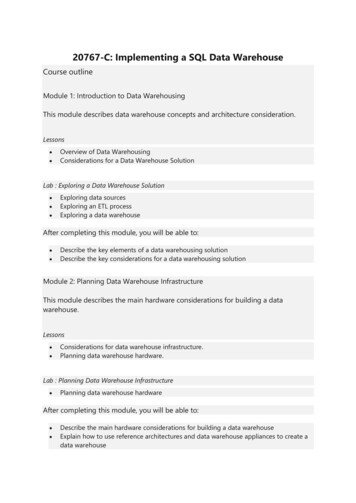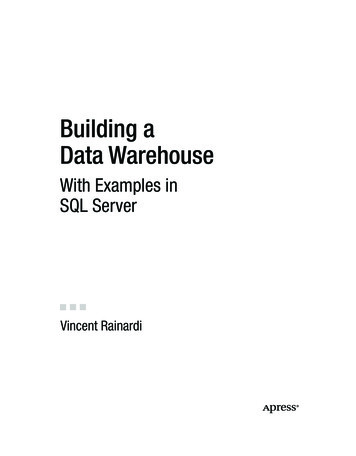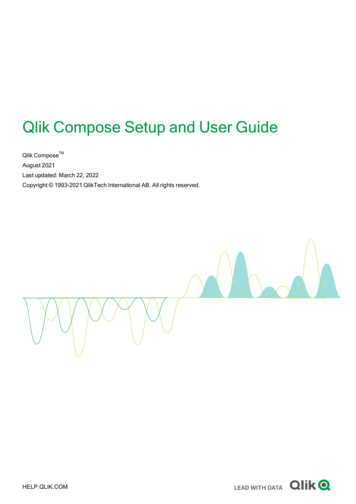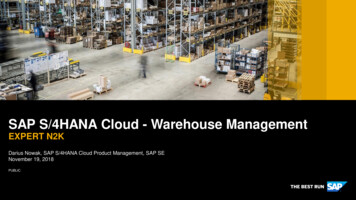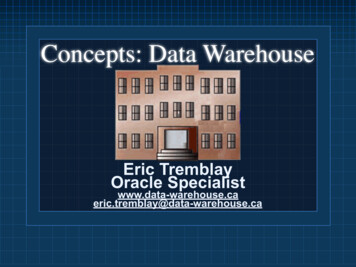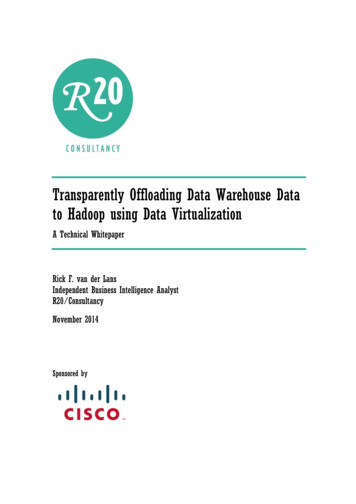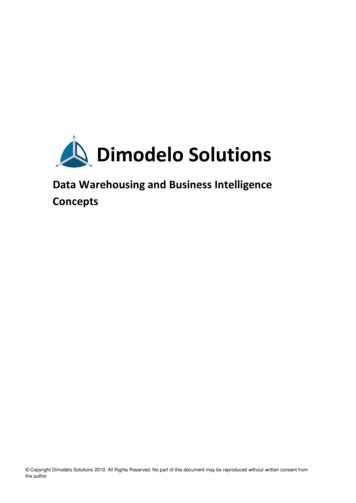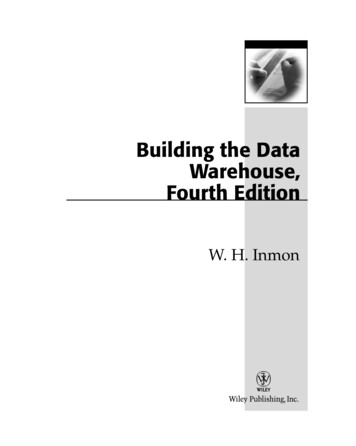
Transcription
Building the DataWarehouse,Fourth EditionW. H. Inmon
Building the Data Warehouse,Fourth Edition
Building the DataWarehouse,Fourth EditionW. H. Inmon
Building the Data Warehouse, Fourth EditionPublished byWiley Publishing, Inc.10475 Crosspoint BoulevardIndianapolis, IN 46256www.wiley.comCopyright 2005 by Wiley Publishing, Inc., Indianapolis, IndianaPublished simultaneously in CanadaNo part of this publication may be reproduced, stored in a retrieval system or transmittedin any form or by any means, electronic, mechanical, photocopying, recording, scanning orotherwise, except as permitted under Sections 107 or 108 of the 1976 United States Copyright Act, without either the prior written permission of the Publisher, or authorizationthrough payment of the appropriate per-copy fee to the Copyright Clearance Center, 222Rosewood Drive, Danvers, MA 01923, (978) 750-8400, fax (978) 646-8600. Requests to thePublisher for permission should be addressed to the Legal Department, Wiley Publishing,Inc., 10475 Crosspoint Blvd., Indianapolis, IN 46256, (317) 572-3447, fax (317) 572-4355, oronline at http://www.wiley.com/go/permissions.Limit of Liability/Disclaimer of Warranty: The publisher and the author make no representations or warranties with respect to the accuracy or completeness of the contents of thiswork and specifically disclaim all warranties, including without limitation warranties offitness for a particular purpose. No warranty may be created or extended by sales or promotional materials. The advice and strategies contained herein may not be suitable forevery situation. This work is sold with the understanding that the publisher is not engagedin rendering legal, accounting, or other professional services. If professional assistance isrequired, the services of a competent professional person should be sought. Neither thepublisher nor the author shall be liable for damages arising herefrom. The fact that an organization or Website is referred to in this work as a citation and/or a potential source of further information does not mean that the author or the publisher endorses the informationthe organization or Website may provide or recommendations it may make. Further, readers should be aware that Internet Websites listed in this work may have changed or disappeared between when this work was written and when it is read.For general information on our other products and services or to obtain technical support,please contact our Customer Care Department within the U.S. at (800) 762-2974, outside theU.S. at (317) 572-3993 or fax (317) 572-4002.Wiley also publishes its books in a variety of electronic formats. Some content that appearsin print may not be available in electronic books.Trademarks: Wiley, the Wiley logo, and related trade dress are trademarks or registeredtrademarks of John Wiley & Sons, Inc. and/or its affiliates, in the United States and othercountries, and may not be used without written permission. All other trademarks are theproperty of their respective owners. Wiley Publishing, Inc., is not associated with any product or vendor mentioned in this book.ISBN-13: 978-0-7645-9944-6ISBN-10: 0-7645-9944-5Manufactured in the United States of America10 9 8 7 6 5 4 3 2 14B/SS/QZ/QV/IN
CreditsExecutive EditorRobert ElliottProject CoordinatorErin SmithDevelopment EditorKevin ShaferCopy EditorKathi DugganGraphics and Production SpecialistsJonelle BurnsKelly EmkowCarrie A. FosterJoyce HaugheyJennifer HeleineStephanie D. JumperEditorial ManagerMary Beth WakefieldQuality Control TechnicianLeeann HarneyProduction ManagerTim TateProofreading and IndexingTECHBOOKS Production ServicesProduction EditorPamela HanleyVice President & Executive GroupPublisherRichard SwadleyVice President and PublisherJoseph B. Wikertv
To Jeanne Friedman and Kevin Gould — friends for all times.
About the AuthorBill Inmon, the father of the data warehouse concept, has written 40 books ondata management, data warehouse, design review, and management of dataprocessing. Bill has had his books translated into Russian, German, French,Japanese, Portuguese, Chinese, Korean, and Dutch. Bill has published morethan 250 articles in many trade journals. Bill founded and took public PrismSolutions. His latest company — Pine Cone Systems — builds software for themanagement of the data warehouse/data mart environment. Bill holds twosoftware patents. Articles, white papers, presentations, and much more material can be found on his Web site, www.billinmon.com.ix
ContentsPrefacexixAcknowledgmentsChapter 1Evolution of Decision Support SystemsThe EvolutionThe Advent of DASDPC/4GL TechnologyEnter the Extract ProgramThe Spider WebChapter 2xxvii124456Problems with the Naturally Evolving Architecture7Lack of Data CredibilityProblems with ProductivityFrom Data to InformationA Change in ApproachThe Architected EnvironmentData Integration in the Architected EnvironmentWho Is the User?791214161820The Development Life CyclePatterns of Hardware UtilizationSetting the Stage for Re-engineeringMonitoring the Data Warehouse EnvironmentSummary2022232528The Data Warehouse EnvironmentThe Structure of the Data WarehouseSubject OrientationDay 1 to Day n Phenomenon29333439xi
xiiContentsGranularityThe Benefits of GranularityAn Example of GranularityDual Levels of GranularityExploration and Data MiningLiving Sample DatabasePartitioning as a Design ApproachPartitioning of DataChapter 34142434650505353Structuring Data in the Data WarehouseAuditing and the Data WarehouseData Homogeneity and HeterogeneityPurging Warehouse DataReporting and the Architected EnvironmentThe Operational Window of OpportunityIncorrect Data in the Data WarehouseSummary5661616464656769The Data Warehouse and DesignBeginning with Operational DataProcess and Data Models and the Architected EnvironmentThe Data Warehouse and Data Models71717879The Data Warehouse Data ModelThe Midlevel Data ModelThe Physical Data ModelThe Data Model and Iterative DevelopmentNormalization and DenormalizationSnapshots in the Data WarehouseMetadataManaging Reference Tables in a Data WarehouseCyclicity of Data — The Wrinkle of TimeComplexity of Transformation and IntegrationTriggering the Data Warehouse RecordEventsComponents of the SnapshotSome ExamplesProfile RecordsManaging VolumeCreating Multiple Profile RecordsGoing from the Data Warehouse to theOperational EnvironmentDirect Operational Access of Data Warehouse DataIndirect Access of Data Warehouse DataAn Airline Commission Calculation SystemA Retail Personalization SystemCredit ScoringIndirect Use of Data Warehouse 117118119119121123125
ContentsChapter 4Star JoinsSupporting the ODSRequirements and the Zachman FrameworkSummary126133134136Granularity in the Data WarehouseRaw EstimatesInput to the Planning ProcessData in Overflow139140141142Overflow StorageChapter 5144What the Levels of Granularity Will BeSome Feedback Loop TechniquesLevels of Granularity — Banking EnvironmentFeeding the Data MartsSummary147148150157157The Data Warehouse and TechnologyManaging Large Amounts of DataManaging Multiple MediaIndexing and Monitoring DataInterfaces to Many TechnologiesProgrammer or Designer Control of Data PlacementParallel Storage and Management of Data159159161162162163164Metadata ManagementLanguage InterfaceEfficient Loading of DataEfficient Index UtilizationCompaction of DataCompound KeysVariable-Length DataLock ManagementIndex-Only ProcessingFast RestoreOther Technological FeaturesDBMS Types and the Data WarehouseChanging DBMS TechnologyMultidimensional DBMS and the Data WarehouseData Warehousing across Multiple Storage MediaThe Role of Metadata in the Data Warehouse EnvironmentContext and ContentThree Types of Contextual InformationCapturing and Managing Contextual InformationLooking at the PastRefreshing the Data 171172172174175182182185186187187188190191xiii
xivContentsChapter 6The Distributed Data WarehouseTypes of Distributed Data WarehousesLocal and Global Data WarehousesThe Local Data WarehouseThe Global Data WarehouseIntersection of Global and Local DataRedundancyAccess of Local and Global DataThe Technologically Distributed Data WarehouseThe Independently Evolving Distributed Data WarehouseThe Nature of the Development EffortsCompletely Unrelated WarehousesDistributed Data Warehouse DevelopmentCoordinating Development across Distributed LocationsThe Corporate Data Model — DistributedMetadata in the Distributed WarehouseBuilding the Warehouse on Multiple LevelsMultiple Groups Building the Current Level of DetailDifferent Requirements at Different LevelsOther Types of Detailed 7218219223223226228232234Multiple Platforms for Common Detail DataSummary235236Chapter 7Executive Information Systems and the Data WarehouseEIS — The PromiseA Simple ExampleDrill-Down AnalysisSupporting the Drill-Down ProcessThe Data Warehouse as a Basis for EISWhere to TurnEvent MappingDetailed Data and EISKeeping Only Summary Data in the EISSummary239240240243245247248251253254255Chapter 8External Data and the Data WarehouseExternal Data in the Data WarehouseMetadata and External DataStoring External DataDifferent Components of External DataModeling and External DataSecondary ReportsArchiving External DataComparing Internal Data to External DataSummary257260261263264265266267267268
ContentsChapter 9Migration to the Architected EnvironmentA Migration PlanThe Feedback LoopStrategic ConsiderationsMethodology and MigrationA Data-Driven Development MethodologyData-Driven MethodologySystem Development Life CyclesA Philosophical apter 10 The Data Warehouse and the WebSupporting the eBusiness EnvironmentMoving Data from the Web to the Data WarehouseMoving Data from the Data Warehouse to the WebWeb SupportSummary289299300301302302Chapter 11 Unstructured Data and the Data WarehouseIntegrating the Two Worlds305307Text — The Common LinkA Fundamental MismatchMatching Text across the EnvironmentsA Probabilistic MatchMatching All the InformationA Themed MatchIndustrially Recognized ThemesNaturally Occurring ThemesLinkage through Themes and Themed WordsLinkage through Abstraction and MetadataA Two-Tiered Data WarehouseDividing the Unstructured Data WarehouseDocuments in the Unstructured Data WarehouseVisualizing Unstructured DataA Self-Organizing Map (SOM)The Unstructured Data WarehouseVolumes of Data and the Unstructured Data WarehouseFitting the Two Environments TogetherSummaryChapter 12 The Really Large Data WarehouseWhy the Rapid Growth?The Impact of Large Volumes of DataBasic Data-Management ActivitiesThe Cost of StorageThe Real Costs of StorageThe Usage Pattern of Data in the Face of Large 24325326327330331332333334335336336xv
xviContentsA Simple CalculationTwo Classes of DataImplications of Separating Data into Two ClassesDisk Storage in the Face of Data SeparationNear-Line StorageAccess Speed and Disk StorageArchival StorageImplications of TransparencyMoving Data from One Environment to AnotherThe CMSM ApproachA Data Warehouse Usage MonitorThe Extension of the Data Warehouseacross Different Storage MediaInverting the Data WarehouseTotal CostMaximum CapacitySummaryChapter 13 The Relational and the Multidimensional Modelsas a Basis for Database DesignThe Relational ModelThe Multidimensional ModelSnowflake StructuresDifferences between the ModelsThe Roots of the DifferencesReshaping Relational DataIndirect Access and Direct Access of DataServicing Future Unknown NeedsServicing the Need to Change GracefullyIndependent Data MartsBuilding Independent Data MartsSummaryChapter 14 Data Warehouse Advanced TopicsEnd-User Requirements and the Data WarehouseThe Data Warehouse and the Data ModelThe Relational FoundationThe Data Warehouse and Statistical ProcessingResource Contention in the Data WarehouseThe Exploration WarehouseThe Data Mining WarehouseFreezing the Exploration WarehouseExternal Data and the Exploration WarehouseData Marts and Data Warehouses in the Same ProcessorThe Life Cycle of DataMapping the Life Cycle to the Data Warehouse EnvironmentTesting and the Data 77378378379380380382383384384386387388
ContentsTracing the Flow of Data through the Data WarehouseData Velocity in the Data Warehouse“Pushing” and “Pulling” DataData Warehouse and the Web-Based eBusiness EnvironmentThe Interface between the Two EnvironmentsThe Granularity ManagerProfile RecordsThe ODS, Profile Records, and PerformanceThe Financial Data WarehouseThe System of RecordA Brief History of Architecture — Evolvingto the Corporate Information FactoryEvolving from the 6CIF — Into the Future406AnalyticsERP/SAPUnstructured DataVolumes of Data406407408409Summary410Chapter 15 Cost-Justification and Return on Investmentfor a Data WarehouseCopying the CompetitionThe Macro Level of Cost-JustificationA Micro Level Cost-JustificationInformation from the Legacy Environment413413414415418The Cost of New InformationGathering Information with a Data WarehouseComparing the CostsBuilding the Data WarehouseA Complete PictureInformation Frustration419419420420421422The Time Value of DataThe Speed of InformationIntegrated InformationThe Value of Historical DataHistorical Data and CRMSummaryChapter 16 The Data Warehouse and the ODSComplementary StructuresUpdates in the ODSHistorical Data and the ODSProfile RecordsDifferent Classes of ODSDatabase Design — A Hybrid i
xviii ContentsDrawn to ProportionTransaction Integrity in the ODSTime Slicing the ODS DayMultiple ODSODS and the Web EnvironmentAn Example of an ODSSummaryChapter 17 Corporate Information Compliance andData WarehousingTwo Basic ActivitiesFinancial ComplianceThe “What”The “Why”Auditing Corporate 6447449452454Chapter 18 The End-User CommunityThe FarmerThe ExplorerThe MinerThe TouristThe CommunityDifferent Types of DataCost-Justification and ROI AnalysisSummary457458458459459459460461462Chapter 19 Data Warehouse Design Review ChecklistWhen to Do a Design ReviewWho Should Be in the Design Review?What Should the Agenda Be?The ResultsAdministering the ReviewA Typical Data Warehouse Design ferencesArticlesBooksWhite PapersIndex507507510512517
Preface for theSecond EditionDatabases and database theory have been around for a long time. Early renditions of databases centered around a single database serving every purposeknown to the information processing community—from transaction to batchprocessing to analytical processing. In most cases, the primary focus of theearly database systems was operational—usually transactional—processing.In recent years, a more sophisticated notion of the database has emerged—onethat serves operational needs and another that serves informational or analytical needs. To some extent, this more enlightened notion of the database is dueto the advent of PCs, 4GL technology, and the empowerment of the end user.The split of operational and informational databases occurs for manyreasons: The data serving operational needs is physically different data fromthat serving informational or analytic needs. The supporting technology for operational processing is fundamentallydifferent from the technology used to support informational or analytical needs. The user community for operational data is different from the oneserved by informational or analytical data. The processing characteristics for the operational environment and theinformational environment are fundamentally different.Because of these reasons (and many more), the modern way to build systems is to separate the operational from the informational or analytical processing and data.xix
xxPreface for the Third EditionThis book is about the analytical [or the decision support systems (DSS)]environment and the structuring of data in that environment. The focus of thebook is on what is termed the “data warehouse” (or “information warehouse”), which is at the heart of informational, DSS processing.The discussions in this book are geared to the manager and the developer.Where appropriate, some level of discussion will be at the technical level. But,for the most part, the book is about issues and techniques. This book is meantto serve as a guideline for the designer and the developer.When the first edition of Building the Data Warehouse was printed, the database theorists scoffed at the notion of the data warehouse. One theoreticianstated that data warehousing set back the information technology industry 20years. Another stated that the founder of data warehousing should not beallowed to speak in public. And yet another academic proclaimed that datawarehousing was nothing new and that the world of academia had knownabout data warehousing all along although there were no books, no articles, noclasses, no seminars, no conferences, no presentations, no references, no papers,and no use of the terms or concepts in existence in academia at that time.When the second edition of the book appeared, the world was mad for anything of the Internet. In order to be successful it had to be “e” something—e-business, e-commerce, e-tailing, and so forth. One venture capitalistwas known to say, “Why do we need a data warehouse when we have theInternet?”But data warehousing has surpassed the database theoreticians who wantedto put all data in a single database. Data warehousing survived the dot.comdisaster brought on by the short-sighted venture capitalists. In an age whentechnology in general is spurned by Wall Street and Main Street, data warehousing has never been more alive or stronger. There are conferences, seminars, books, articles, consulting, and the like. But mostly there are companiesdoing data warehousing, and making the discovery that, unlike the overhypedNew Economy, the data warehouse actually delivers, even though SiliconValley is still in a state of denial.Preface for the Third EditionThe third edition of this book heralds a newer and even stronger day for datawarehousing. Today data warehousing is not a theory but a fact of life. Newtechnology is right around the corner to support some of the more exotic needsof a data warehouse. Corporations are running major pieces of their businesson data warehouses. The cost of information has dropped dramaticallybecause of data warehouses. Managers at long last have a viable solution to theugliness of the legacy systems environment. For the first time, a corporate“memory” of historical information is available. Integration of data across thecorporation is a real possibility, in most cases for the first time. Corporations
Preface for the Third Editionare learning how to go from data to information to competitive advantage. Inshort, data warehousing has unlocked a world of possibility.One confusing aspect of data warehousing is that it is an architecture, not atechnology. This frustrates the technician and the venture capitalist alikebecause these people want to buy something in a nice clean box. But datawarehousing simply does not lend itself to being “boxed up.” The differencebetween an architecture and a technology is like the difference between SantaFe, New Mexico, and adobe bricks. If you drive the streets of Santa Fe youknow you are there and nowhere else. Each home, each office building, eachrestaurant has a distinctive look that says “This is Santa Fe.” The look and stylethat makes Santa Fe distinctive are the architecture. Now, that architecture ismade up of such things as adobe bricks and exposed beams. There is a wholeart to the making of adobe bricks and exposed beams. And it is certainly truethat you could not have Santa Fe architecture without having adobe bricks andexposed beams. But adobe bricks and exposed beams by themselves do notmake an architecture. They are independent technologies. For example, youhave adobe bricks throughout the Southwest and the rest of the world that arenot Santa Fe architecture.Thus it is with architecture and technology, and with data warehousing anddatabases and other technology. There is the architecture, then there is theunderlying technology, and they are two very different things. Unquestionably, there is a relationship between data warehousing and database technology, but they are most certainly not the same. Data warehousing requires thesupport of many different kinds of technology.With the third edition of this book, we now know what works and whatdoes not. When the first edition was written, there was some experience withdeveloping and using warehouses, but truthfully, there was not the broad baseof experience that exists today. For example, today we know with certainty thefollowing: Data warehouses are built under a different development methodologythan applications. Not keeping this in mind is a recipe for disaster. Data warehouses are fundamentally different from data marts. The twodo not mix—they are like oil and water. Data warehouses deliver on their promise, unlike many overhypedtechnologies that simply faded away. Data warehouses attract huge amounts of data, to the point that entirelynew approaches to the management of large amounts of data arerequired.But perhaps the most intriguing thing that has been learned about datawarehousing is that data warehouses form a foundation for many other formsof processing. The granular data found in the data warehouse can be reshapedand reused. If there is any immutable and profound truth about data warehouses, it is that data warehouses provide an ideal foundation for many otherxxi
xxiiPreface for the Third Editionforms of information processing. There are a whole host of reasons why thisfoundation is so important: There is a single version of the truth. Data can be reconciled if necessary. Data is immediately available for new, unknown uses.And, finally, data warehousing has lowered the cost of information in theorganization. With data warehousing, data is inexpensive to get to and fast toaccess.Databases and database theory have been around for a long time. Early renditions of databases centered around a single database serving every purposeknown to the information processing community—from transaction to batchprocessing to analytical processing. In most cases, the primary focus of theearly database systems was operational—usually transactional—processing.In recent years, a more sophisticated notion of the database has emerged—onethat serves operational needs and another that serves informational or analytical needs. To some extent, this more enlightened notion of the database is dueto the advent of PCs, 4GL technology, and the empowerment of the end user.The split of operational and informational databases occurs for many reasons: The data serving operational needs is physically different data fromthat serving informational or analytic needs. The supporting technology for operational processing is fundamentallydifferent from the technology used to support informational or analytical needs. The user community for operational data is different from the oneserved by informational or analytical data. The processing characteristics for the operational environment and theinformational environment are fundamentally different.For these reasons (and many more), the modern way to build systems is toseparate the operational from the informational or analytical processing anddata.This book is about the analytical or the DSS environment and the structuring of data in that environment. The focus of the book is on what is termed thedata warehouse (or information warehouse), which is at the heart of informational, DSS processing.What is analytical, informational processing? It is processing that serves theneeds of management in the decision-making process. Often known as DSSprocessing, analytical processing looks across broad vistas of data to detecttrends. Instead of looking at one or two records of data (as is the case in operational processing), when the DSS analyst does analytical processing, manyrecords are accessed.
Preface for the Third Edition xxiiiIt is rare for the DSS analyst to update data. In operational systems, data isconstantly being updated at the individual record level. In analytical processing, records are constantly being accessed, and their contents are gathered foranalysis, but little or no alteration of individual records occurs.In analytical processing, the response time requirements are greatly relaxedcompared to those of traditional operational processing. Analytical responsetime is measured from 30 minutes to 24 hours. Response times measured inthis range for operational processing would be an unmitigated disaster.The network that serves the analytical community is much smaller than theone that serves the operational community. Usually there are far fewer users ofthe analytical network than of the operational network.Unlike the technology that serves the analytical environment, operationalenvironment technology must concern itself with data and transaction locking, contention for data, deadlock, and so on.There are, then, many major differences between the operational environment and the analytical environment. This book is about the analytical, DSSenvironment and addresses the following issues: Granularity of data Partitioning of data Meta data Lack of credibility of data Integration of DSS data The time basis of DSS data Identifying the source of DSS data-the system of record Migration and methodologyThis book is for developers, managers, designers, data administrators, database administrators, and others who are building systems in a modern dataprocessing environment. In addition, students of information processing willfind this book useful. Where appropriate, some discussions will be more technical. But, for the most part, the book is about issues and techniques, and it ismeant to serve as a guideline for the designer and the developer.This book is the first in a series of books relating to data warehouse. The nextbook in the series is Using the Data Warehouse (Wiley, 1994). Using the DataWarehouse addresses the issues that arise once you have built the data warehouse. In addition, Using the Data Warehouse introduces the concept of alarger architecture and the notion of an operational data store (ODS). An operational data store is a similar architectural construct to the data warehouse,except the ODS applies only to operational systems, not informational systems. The third book in the series is Building the Operational Data Store(Wiley, 1999), which addresses the issues of what an ODS is and how an ODSis built.
xxiv Preface for the Fourth EditionThe next book in the series is Corporate Information Factory, Third Edition(Wiley, 2002). This book addresses the larger framework of which the datawarehouse is the center. In many regards the CIF book and the DW book arecompanions. The CIF book provides the larger picture and the DW bookprovides a more focused discussion. Another related book is ExplorationWarehousing (Wiley, 2000). This book addresses a specialized kind of processing-pattern analysis using statistical techniques on data found in the datawarehouse.Building the Data Warehouse, however, is the cornerstone of all the relatedbooks. The data warehouse forms the foundation of all other forms of DSSprocessing.There is perhaps no more eloquent testimony to the advances made by datawarehousing and the corporate information factory than the References at theback of this book. When the first edition was published, there were no otherbooks, no white papers, and only a handful of articles that could be referenced.In this third edition, there are many books, articles, and white papers that arementioned. Indeed the references only start to explore some of the moreimportant works.Preface for the Fourth EditionIn the beginning was a theory of database that held that all data should be heldin a common source. It was easy to see how this notion came about. Prior todatabase, there were master files. These master files resided on sequentialmedia and were built for every application that came along. There wasabsolutely no integration among master files. Thus, the idea of integratingdata into a single source — a database — held great appeal.It was into this mindset that data warehouse was born. Data warehousingwas an intellectual threat to those who subscribed to conventional databasetheory because data warehousing suggested that there ought to be differentkinds of databases. And the thought that there should be different kinds ofdatabases was not accepted by the database theoreticians.Today, data warehousing has achieved the status of conventional wisdom.For a variety of reasons, data warehousing is just what you do. Recently a survey showed that corporate spending on data warehouse and business intelligence surpassed spending on transactional processing and OLTP, somethingunthinkable a few years back.The day of data warehouse maturity has arrived.It is appropriate, then, that the Fourth Edition of the book that began thedata warehousing phenomenon has been written.In addition to the time-honored concepts of data warehousing, this editioncontains the data warehouse basics. But it also contains many topics current totoday’s information infrastructure.
Preface for the Fourth EditionFollowing are some of the more important new topics in this edition: Compliance (dealing with Sarbanes Oxley, HIPAA, Basel II, and more) Near line storage (extending the data warehouse to infinity) Multi dimensional database design Unstructured data End users (who they ar
Direct Operational Access of Data Warehouse Data 118 Indirect Access of Data Warehouse Data 119 An Airline Commission Calculation System 119 A Retail Personalization System 121 Credit Scoring 123 Indirect Use of Data Warehouse Data 125. xii Contents. 02_599445 ftoc.qxd 9/2/05 8:56 AM Page xii



